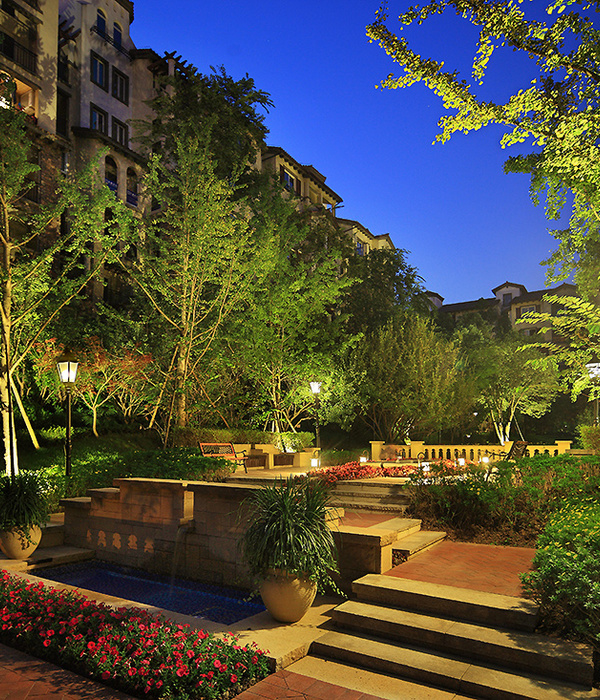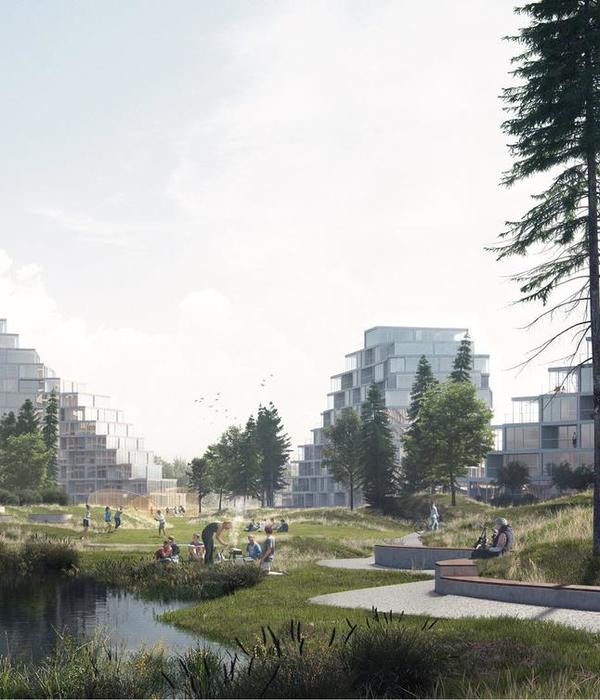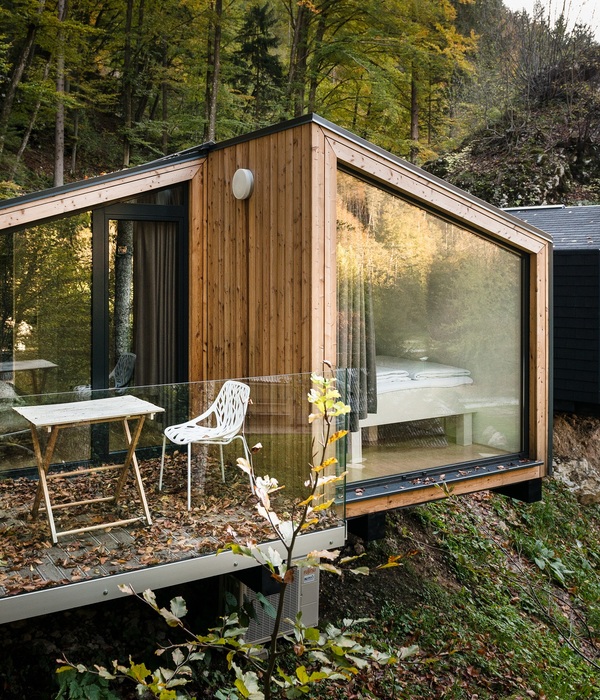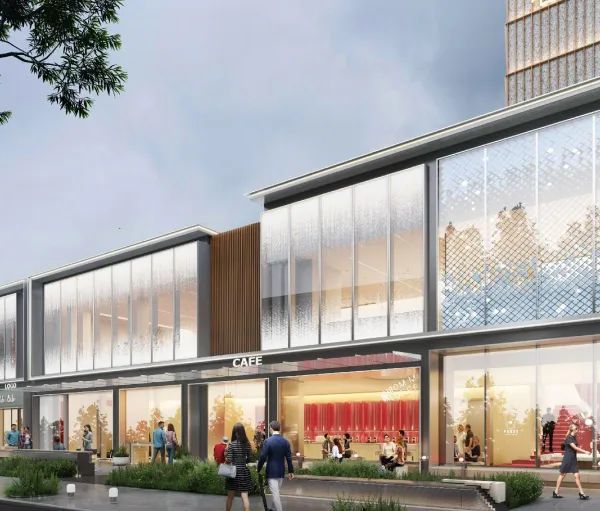高速度和高密度已成了地处亚热地带的南中国城市深圳的代名词。这座沿着珠江口出海口东侧滨海带状规划的超级城市中的人口和建筑密度依然与日俱增,超高层建筑中的居住和工作已成为这座城市的日常。城市里的休闲、甚至教育都被带进高空之中。
High speed and high density have become synonymous with Shenzhen, the southern Chinese city in the sub-tropical coast area. The population and urban density of this hyper-city along the eastern side of the Pearl River Estuary is still booming, even after 40 years of rapid development. Living and working in super high-rises has become the daily life of the city. Leisure and even education have also been brought into the sky.
▼自然背景之中的学校全景,The school building in a background of urban nature ©张超
▼向城市打开的立体山谷庭院,The Valley courtyard open to the city©张超
红岭实验小学及其周边城市的所在地原本是福田区西北部的一座名为安托山的小山。这座小山在城市中广为人知是因为它供给了大量用于城市填海扩张的花岗岩土石方,以至于山体被基本削平,仅剩在小学西侧的一座孤独的小山包。其余场地在采石行动逐步退出后被平整为城市开发用地。红岭实验小学的建设用地约 100 米见方,原规划 24 班小学,后因学位缺口巨大而增容至 36 班。现建筑面积约为原规划的两倍,建筑容积率超过 3.0。加上用地东南角基础对地铁线路的避让、道路退缩以及规范上对日照间距(虽然这在亚热带气候的南方常被质疑,但到目前为止仍是强制性的要求)的规定,使得建筑设计面临诸多空间上的挑战。
▼安托山遗存的山包和小学新校园概念,The remaining granite hill and the conception of the new school building
▼亚热带气候下的高密度策略,The spatial trategy in response to the subtropical climate
The building site of Hongling Experimental Primary School (HEPS) and its surrounding cities was originally a hill named Antuoshan in the north-west part of Futian District. This hill is widely known in the city because it had provided a huge quantity of granite earthwork for urban reclamation. As a result, the hill almost disappears, except a small lonely part standing to the west of the school site. The rest of the terrain was levelled into urban development land after the gradual withdraw of the quarrying operation. The site of HEPS, originally planned for a 24-class school, is about 100 by 100 meters. Its current capacity has increased to 36 classes due to the huge pressure from the lack of school places, with a total floor area doubled of the original planning. The building ratio is over 3. Besides, giving way to the subway line at the southeast corner, the retreat from the road on all sides, and the building code of the sunshine spacing (although often questioned in the south of the country, but it is still a mandatory requirement), the architectural design has to confront many challenges form the space.
▼东立面运动场上水平错动的教学楼,The dynamic E-shape floor slabs presenting on the sport field©张超
▼东立面运动场下的社团活动空间,Student interest group spaces hung bellow the sport field on the east facade©张超
▼南立面全景,The south facade presenting the esat & west halves in different height©张超
▼高密度城市背景下的校园建筑,The school building neighboring super-highrise residential towers©张超
因此,校园垂直向度的策略变得至关重要。超过 24 米的高层校舍在深圳小学建筑中已经被广泛采用,但相应的副作用是垂直方向的交通过多以及楼梯间需要被封闭和增加前室而阻隔了小学生们的交往。建筑师在红岭实验小学的设计中努力把建筑总高控制在 24 米以下,以创造水平交往和在建筑/景观空间上回应对儿童的身体和心理特点。
▼水平的高密度策略,The low-rise strategy of the school
Therefore, design strategy on the vertical orientation becomes crucial. School buildings over 24 meters (the division number between low-rise and high-rise buildings) have been widely applied in Shenzhen’s primary schools, but the side-effect is the obstruction of the students’ interaction caused by overmany vertical traffic and the compulsory closed fire staircases. In the scheme of the HEPS, the architect make effort to control the building height of within 24 meters, to encourage horizontal interactions and tries to respond to the physical and psychological characteristics of children in the architectural/landscape spatial design.
▼层叠交错的立体复合空间,The spatial dynamics of the Valley courtyard©张超
教学建筑几乎满铺可以建设的用地,建筑分为东西高度不同的两个半区,平面上以两个镜像的 E 字形连接。西半区利用学习单元之间所必须的间距创造出两个曲线形边界的“山谷”庭院。庭院下沉至地下一层,结合由道路退缩距离中取得的边坡绿化,为地下一层的文体设施和餐厅空间争取充足的采光和自然通风。
▼E 形教学楼层,The 6 pairs of learning units on the E-shape floor plate
地景公园之上的山谷庭院,Valleycourtyardsabovethelandformpark
The school building, divided into two halves with different heights on the east and west, almost fully covers the land that can be constructed in the site. The general plan is an inter-linking mirrored E-shapes. The West Half uses the obligatory spacing between classroom rows to create a “valley” courtyard with two curved boundaries. The courtyards sink to the underground level, combining with the greenery slope garden obtained from the retreating distance site boundary, strives for the underground cultural/sport facilities and canteen space fully illuminated and naturally ventilated.▼北侧山谷庭院中的的户外剧场,The north Valley courtyard with open-air theater on the bottom©张超
▼山谷庭院,Students running through the open-air theater©黄城强
▼山谷庭院垂直方向错动的层板及透析空间,The cellular fabric presenting in the vertical layering of the floor slabs©吴嗣铭
通透的首层开放架空公园,The whole building elevated from the ground park©张超
▼首层由南向北缓慢上升的架空活动庭园,The ascending playground in the south valley courtyard©吴嗣铭
▼在首层架空活动区嬉戏的孩子们,Children playing on the designed landform playground on the overhead ground©黄城强
▼从彩色洞穴中仰望天空,Looking up to the sky from the colorful cave in the theater©吴嗣铭
▼南侧庭院中新栽的丛生冬青树,The young bushy holly tree growing in the south courtyard©吴嗣铭
▼首层西南角安静的休息区,A quiet resting corner on the ground floor©吴嗣铭
▼教室外自由延展的户外活动空间,Free-form outdoor playground outside the learning units©张超
下沉庭院通过缓坡和露天阶梯剧场与架空且自然起伏的首层地面连接成为一个整体的地景儿童乐园。200 米环形跑道和运动场被置于建筑东半区三层屋面,与西侧主教学建筑的三层平面相连,便于在二、三、四楼上课的小学生们课间到运动区域活动。运动场下方中部是可容纳 300 人的小礼堂,悬挂于镶嵌在地景乐园中的半户外泳池。主教学建筑的四、五层分别为课外教室和教师办公室,而天面屋顶是学校的园艺农场。
▼首层地景生成,the formation of the landform park
▼首层开放地景公园,Axonometric of the ground landform park
The sinking courtyard is connected to the overhead and naturally undulating ground floor through a gentle slope in the south courtyard and an open-air stepping theater in the north courtyard, all together becoming a children’s landform park. The 200-meter circular runway and sports ground are placed on the 3rd floor of the Eastern Half, linked to the 2nd level of the main teaching building on the west side, which offers convenience for students on the 2nd, 3rd and 4th floors to run to the sports area. Underneath of the stadium is a 300-seat auditorium, hanging above the semi-outdoor swimming pool in the landform park. The fourth and fifth floors of the West Half are the extracurricular classrooms and the teacher’s office, while the roof is the school’s horticultural farm.
▼山谷庭院底部的户外剧场,The open-air theater in the north courtyard©张超
北侧山谷庭院底部的半下沉户外剧场上方交错的绿廊,Two green bridges overhanging on the open-air theater in the north valley courtyard©张超
▼运动场北侧下方的下风雨球场,The semi-outdoor basketball field bellow the north part of the sport field©张超
二层社团活动及小剧场环绕的半地下风雨球场,Looking down to the semi-outdoor basketball field from the central corridor on the 1st floor©黄城强
学习单元——传统上称为课室,是小学生们学习和交往基本空间细胞单元。建筑师针对深圳所在的亚热带气候在水平的 E 字形板式楼层平面上构想了成对组合的鼓形平面的教学单元,避免课室过长的连排阻隔自然通风。每层 12 间课室分 3 列共 6 对布置。每个单元对组合可以通过开闭连接部的灵活隔断以满足合班和分班等不同空间需要。鼓形平面展现出比传统矩形学习单元更大的灵活性与自由度,更有利于单元课室里面的多样化的教学模式。课室经过连接后产生的富有韵律的折曲线与各层楼板在内庭院一侧的自由曲线间形成的线性活动场地,为小朋友们课间提供了一个富有活力的半户外活动场地。建筑师利用了场地北高南低的条件让每层的三排课室从南往北各有一米的高差,在 E 形平板上产生了爬升的地景式行进体验。最终,两个“山谷”庭院中各有两道连接庭院两侧不同楼层的阶梯式花园廊桥,在“山谷”的上空悬置了一份独特的观赏和游戏体验。
▼成对的鼓形学习单元为互动式混合式教学提供多种可能性,The pair drum-shape learning unit offering a high flexibility in interactive learning process
The learning unit, traditionally the classroom, is the basic spatial cell for primary school students to learn and communicate. The architect conceived separated pairs of drum-shaped learning units on the horizontal E-shaped floor plan, for the subtropical climate in which Shenzhen is located, to avoid blocking fluent ventilation on the facade. Every 12 classrooms are divided into 3 rows and arranged in 6 pairs. Each unit-pair combination can be flexible in opening to join the two units, and closing to separate the two, by the moveable division wall in-between two units. The drum-shaped plan shows greater flexibility and freedom when compared to the traditional rectangular classrooms. It is also more conducive to a variety of learning and teaching patterns. The rhythmic folding curve outline of the learning units and the curve edge of the courtyard form the linear activity space to shape a dynamic semi-outdoor venue for the children. The architect maintains and uses the height different between the north and south of the site, to make 1-meter slopes to connect between the three rows of learning units on each floor and create also the landform experience on the E-shaped floor plate. In the end, two steel stepped garden bridges hung in the middle of the two “Valley” courtyards, connecting the different floors of the courtyard, are adding unique viewing and gaming experiences over the “Valley”.
▼鼓形学习单元之间的流动的半户外活动空间,The flow semi-outdoor space out of the drum-shape learning units©吴嗣铭
▼左:E 形楼层尽端望向城市的活动空间;右:与三层户外田径场相连的活动空间。Left: Playground looking to the city at the end of the E-shape floor plan; Right:Outdoor playground linking to the sport field on the 2nd floor©张超++ 吴嗣铭
立面的秩序与色彩错动,The inner facade in the courtyard©张超
▼上下层交错的半户外活动空间,Visual interaction in the outdoor spaces between floors©吴嗣铭
▼从南侧山谷庭院仰望天空,Looking up to the sky on the ground of the south courtyard©吴嗣铭
▼在户外运动场上体育课的小学生们,Studens taking PE class on the sport field©吴嗣铭
“山谷”庭院、上下错动的水平层板、疏松的细胞组织以及有机的绿化植入系统均是项目中回应高密度和亚热带的南方气候的建造策略。而更为重要的是,建筑师希望通过红岭实验小学的建造过程和结果进一步探索高速发展之后的高密度城市里公共性设施的全新空间范式。
"Valley" courtyards, dynamic horizontal slabs, loose cellular fabric, and the implanted organic greening systems are the design strategies to response to high-density urban condition and the subtropical southern climates. Furthermore, through the process and results of the HEPS, the architect aims at a new spatial productive paradigm for designing of public facilities in high-density Shenzhen.
▼雨云城市背景中的山谷庭园,The urban scenery of the valley courtyard©黄城强
▼高密度城市背景中层叠的校园,The layering campus in the background of the high-density city©吴嗣铭
▼总平面图和首层平面图,site plan & ground floor plan
▼二层和三层平面图,first floor plan & second floor plan
四层和五层平面图,third floor plan & fourth floor plan
▼剖面图,section
项目名称:红岭实验小学 建筑师:源计划建筑师事务所 O-office Architects 地址:深圳市福田区侨香四道与安托山二路交汇处东北侧 项目年份:2017-2019 建筑总面积:33721平方米 高度:24米 主持建筑师:何健翔,蒋滢 项目建筑师:董京宇,陈晓霖 设计团队:吴一飞,张婉怡,王玥,黄城强,曾维,何文康,蔡乐欢,彭伟森,何振中 现场设计代表:陈晓霖 现场工程管理:深圳市万科房地产有限公司(代建)-赵偲翼,王川,黄鑫 结构顾问:广州容柏生建筑结构设计事务所 结构机电设计:申都设计集团有限公司深圳分公司 其他顾问单位:广州诺科建筑幕墙技术有限公司(幕墙设计),广州尚点园林景观设计有限公司(景观植物),广州哲外艺术设计(TheWhy art x design)有限公司(标识设计),深圳市光艺规划设计有限公司(照明设计),深圳千典建筑与工程设计顾问有限公司(结构超限顾问) 业主:深圳市福田区建工署 摄影师:张超,吴嗣铭,黄城强
Project Name: Hongling Experimental Primary School
Architect: O-office Architects
Project Location: Northeast of the intersection of Qiaoxiang 4th Road and Antuoshan 2nd Road, Futian District, Shenzhen
Period: 2017-2019
Gross Built Area: 33721 sqm
Height: 24 meters
Chief Architects: He Jianxiang & Jiang Ying
Project Architects: Dong Jingyu, Chen Xiaolin
Design Team: Wu Yifei, Zhang Wanyi, Wang Yue, Huang Chengqiang, Zeng Wei, Cai Lehuan, Peng Weisen, He Zhenzhong
Construction Project Management: Shenzhen Vanke Real Estate Co., Ltd. – Zhao Siyi, Huang Xin, Wang Chuan (Site Project Management)Client: Bureau Public Works of Shenzhen Municipality
Structural Consultant: RBS Architectural Engineering Design Associates
Structural & M.E. Design: CMAD Design Group
Other Consultant: Neuco Building Facades Technology Co., Ltd. (Building Facades Design), TOP DESIGN (Landscape Design), TheWhy art x design (VI Design), Shenzhen Guangyi Lighting Planning and Design Co., Ltd. (Lighting Design), Shenzhen QianDian construction and Engineering Design Consulting Co., Ltd.( Structural Overrun Consultant)Photographer:Zhangg Chao, Wu Siming,Nicky Huang
{{item.text_origin}}












